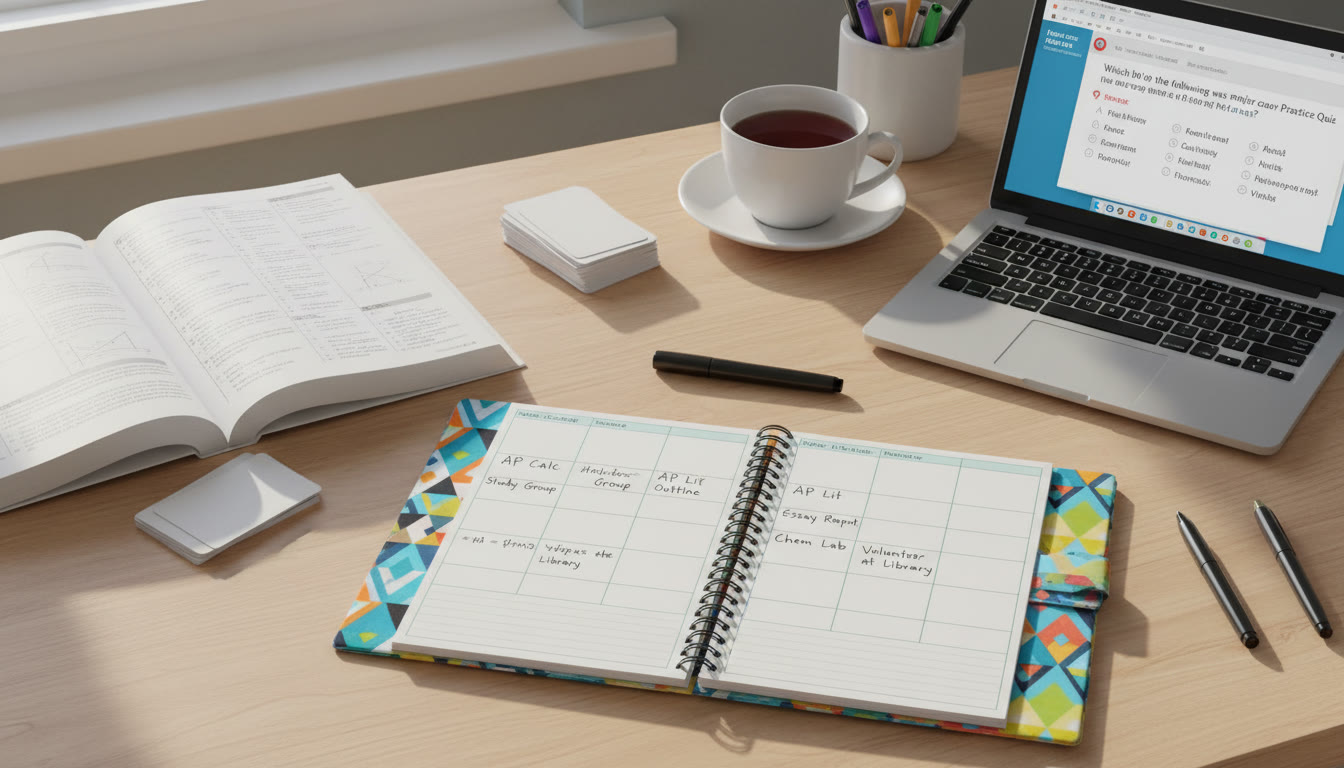Why Time Budgeting Matters for AP Students
If you’ve ever stared at your calendar wondering how to fit AP coursework, extracurriculars, a social life, and sleep into one humane schedule—you’re not alone. AP classes are college-level in scope, and success tends to come from steady effort more than last-minute cramming. Time budgeting gives you a realistic map: how many hours to spend on classwork, review, practice exams, and targeted skill-building each week for each subject.
This guide is written for busy students who want straightforward, practical estimates for weekly hours by AP subject, plus examples of how to shape those hours into a schedule that actually fits a real life. I’ll also highlight study habits, common trade-offs, and how one-on-one help—like Sparkl’s personalized tutoring—can fit naturally into your plan when you need tailored guidance.
How I Estimated Weekly Hour Ranges
Not every student is the same, so think of these ranges as realistic bands rather than fixed rules. Estimates are influenced by four big factors:
- Course difficulty and breadth (e.g., AP Calculus BC vs. AP Psychology)
- Prior knowledge and math/reading baseline
- Whether your course meets daily, block schedule, or is self-paced
- Your goal: understanding, a score of 3, or a top score (4–5)
The ranges below assume a typical high school year where classes meet regularly and you’re aiming for a 3–5 depending on your goals. If you want a personalized assessment, short, targeted sessions with an expert tutor (for example, Sparkl’s 1-on-1 tutors) can help adjust these ranges to your exact needs.
General Weekly Time Budgeting Rules
Rule 1 — Prioritize consistency over marathon sessions
Fifteen focused minutes five times a week beats a single three-hour session for retention. Schedule small, manageable blocks tied to specific tasks (example: 30 minutes of practice problems after school).
Rule 2 — Mix active practice and spaced review
Make sure weekly hours include active work (practice questions, essays, problem sets) and spaced review (flashcards, summary notes, quick topic refreshers).
Rule 3 — Invest time strategically by subject type
Some subjects reward problem volume (Math, Physics), others reward reading and synthesis (English, History). Allocate weekly hours accordingly.
Realistic Weekly Hour Ranges by AP Subject
Below is a practical table you can use as a starting point. Hours listed are per subject, per week, outside of class time (homework plus independent review and practice). Use the lower end if you have strong background or lighter goals; use the higher end if you’re aiming for 4–5 or have weaker prior exposure.
| AP Subject | Weekly Hours (Low) | Weekly Hours (High) | Primary Focus |
|---|---|---|---|
| Calculus AB | 4 | 8 | Problem practice, concept mastery, exam strategy |
| Calculus BC | 6 | 10 | Volume of problems, series, parametrics, AP exam pacing |
| Physics 1/2 | 5 | 9 | Problem-solving, lab concepts, formula application |
| Physics C | 6 | 12 | Advanced problems, calculus-based derivations |
| Chemistry | 4 | 8 | Problem sets, reaction mechanisms, labs |
| Biology | 3 | 7 | Vocabulary, processes, practice FRQs |
| English Language & Composition | 3 | 6 | Writing practice, rhetorical analysis, timed essays |
| English Literature | 3 | 7 | Close reading, literary terms, essay planning |
| U.S. History | 4 | 8 | Content review, document analysis, DBQ practice |
| World History | 3 | 6 | Thematic chronology, practice essays, sourcing |
| European History | 3 | 6 | Chronology, interpretation, DBQs |
| Psychology | 2 | 5 | Terms, experiments, application |
| Economics (Micro/Macro) | 3 | 6 | Graphs, models, essay/application practice |
| Computer Science A | 4 | 8 | Code practice, algorithm problems, AP-style coding |
| Statistics | 3 | 7 | Problem solving, interpretation, practice exams |
| Art and Design | 3 | 10 | Portfolio development, sustained investigations |
How to Read the Table and Apply It to Your Week
Think of the low–high range as a sliding scale: if you’ve taken a course prerequisite (Algebra II for Calculus, or Biology for AP Biology) you can lean toward the low end. If the exam is your clearest path to college credit or you want a 4–5, lean toward the high end and add targeted practice tests.
Here’s a practical example. Suppose you’re taking three APs: Calculus AB (6 hours target), AP Biology (5 hours target), and AP English Language (4 hours target). That’s 15 hours weekly outside class—about 3 hours per weekday or concentrated weekend blocks. If you have limited weekdays, break sessions into 30–60 minute chunks and schedule one longer session on Saturday for synthesis and practice tests.
Weekly Study Templates You Can Use
Template A: Daily Small-Bite Plan (for busy weeknights)
Best for students with after-school commitments who prefer consistency.
- Mon–Fri: 45–60 minutes spread across two subjects (total 45–60 min/day)
- Wed: 10–15 minute quick review of all subjects using flashcards or summary sheets
- Sat: 2–3 hour block (practice exam, write an essay, or problem set)
- Sun: Rest and light review (30–45 minutes) + plan the week
Template B: Block Study (for concentrated learners)
Best for block schedules or weekend-heavy calendars.
- Mon, Wed, Fri: 90–120 minute focused blocks on one subject each
- Tue, Thu: 45–60 minute review for second and third subjects
- Sat: 3–4 hour practice test or portfolio work
- Sun: Active rest (light review plus planning)
Balancing Multiple APs — A Practical Approach
When you stack APs, total weekly hours can grow quickly. Two strategies help:
- Rotate intensity: treat one AP as “high focus” in a week and the others as maintenance, then rotate.
- Cross-train study skills: use one session to strengthen a transferable skill (e.g., essay structure helps History and English; graph interpretation helps Economics and Biology).
For example, three APs with mid-range targets (Calculus BC 8, US History 6, Chemistry 6) total 20 hours/week outside class. You can manage this by doing shorter daily sessions and two longer weekend blocks: one for problem-heavy subjects (Calculus/Chemistry) and one for essay and synthesis (US History).
How to Use Practice Tests in Your Weekly Budget
Practice exams are priceless because they reveal weak spots and build pacing. Treat them as both assessment and study:
- Low frequency, high value: one mid-length practice set every 2–3 weeks; one full timed practice exam every 4–6 weeks.
- Post-test plan: spend 50% of the following week’s study time focused on the errors revealed by the practice test.
For example, if you did a 3-hour practice exam on Saturday, spend the next week’s allocated hours fixing weak content areas rather than consuming new material.
Examples by Student Profile
Profile 1 — The Competitive Senior (Applying to Selective Colleges)
Goal: 4–5 scores where possible. Schedule choice: high-end weekly hours.
- 3 APs: target total 18–24 hours/week outside class
- Weekly rhythm: daily 60–90 minute sessions per AP in rotation, weekend practice tests
- Use short, targeted tutoring sessions for weak domains—Sparkl’s 1-on-1 guidance can be useful for last-mile improvements and tailored study plans.
Profile 2 — The Balanced Junior (Grades Matter and College Credit Helps)
Goal: solid scores and a sustainable school year. Schedule choice: mid-range weekly hours.
- 2–3 APs: target 10–16 hours/week outside class
- Weekly rhythm: short nightly reviews, one long weekend block, targeted practice once a week
- Consider occasional tutoring to shore up foundational gaps or to practice FRQs and pacing.
Profile 3 — The First-Time AP Taker
Goal: pass the exam while learning the material. Schedule choice: start low and increase as confidence grows.
- 1–2 APs: target 6–10 hours/week outside class
- Weekly rhythm: daily small study sessions, frequent check-ins with teacher, progress checks through practice questions
- Short tutoring check-ins (if available) can help create a tailored study plan and accelerate skills.
Study Activities That Count Toward Weekly Hours
Not all study is equal. Make sure your hours include a mix of:
- Active practice (problem sets, practice MCQs, coding duties)
- Timed essays and free-response question practice
- Spaced review (flashcards, summary sheets, quick quizzes)
- Metacognitive review (error logs, reflection on practice tests)
- Targeted concept repair (mini-lessons on weak topics)
Weekly Hours Checklist — A Template You Can Copy
Use this checklist to audit your week. Tally the actual minutes so you can compare against your target ranges and adjust.
- Active problem practice: _____ minutes
- Timed FRQs/Essays: _____ minutes
- Spaced review (flashcards): _____ minutes
- Practice tests or sections: _____ minutes
- Tutoring / 1-on-1 sessions: _____ minutes
- Reflection & planning: _____ minutes
When to Increase or Decrease Weekly Hours
Be flexible. Add time when:
- Your practice test score plateaus or declines.
- You switch from learning to review mode (the month(s) before the exam often need more hours).
- You identify persistent weak topics that require more deliberate practice.
Reduce hours when:
- You’ve shown sustained performance at your target score range and need to avoid burnout.
- Other high-priority life events require temporary reallocation (college apps, family obligations, health).
How Personalized Tutoring Fits Naturally
One of the smartest uses of limited weekly hours is to make them more efficient—fewer hours, higher impact. That’s where personalized tutoring helps: targeted 1-on-1 sessions can pinpoint misconceptions, streamline a study plan, and provide pacing strategies tailored to the AP exam format.
For example, a student spending 6 hours weekly on Calculus might waste time on problems that don’t reflect AP priorities. A short run of expert sessions—reviewing exam format, typical pitfalls, and time-saving techniques—can convert those same hours into better results. Sparkl’s personalized tutoring offers tailored study plans, expert tutors, and AI-driven insights that can help students focus the weekly time budget where it matters most.
Common Time-Saving Strategies
- Active recall over passive re-reading—practice questions beat highlighting.
- Track errors and revisit them in the next session rather than repeating fresh practice.
- Group related tasks: do all short flashcard reviews at one time instead of randomly.
- Use the Pomodoro method for focused sprints when energy is low.
Real-World Example: A 16-Week Review Plan
Here’s a compact plan to put the weekly ranges into a semester-length context (16 weeks before exam). This assumes you’ve been in the course all year and are shifting into exam mode.
- Weeks 16–12: Diagnostic practice test, set baseline, allocate weekly hours around weak topics.
- Weeks 11–8: Deep practice phase—daily targeted practice and weekly timed sections.
- Weeks 7–4: Practice test cadence increases to one full test every 2 weeks; error logging and topic repair.
- Weeks 3–1: Final pacing, light review, rest and confidence building; peak performance tactics (sleep, nutrition, timed practice).
Adjust hours per the table above. If you have a Sparkl tutor or similar, schedule at least one session in Weeks 16 and 4 for targeted strategy work.
Handling Burnout: The Human Side of a Schedule
Schedules fail when they ignore human limits. Burnout reduces efficiency, so build rest into your weekly hours. Plan micro-breaks, a weekly social hour, and at least one no-study block each week. Over time, consistent moderate study beats aggressive short-term pushes.
Measuring Progress: Metrics That Matter
Don’t just track hours—track effectiveness. Useful metrics include:
- Percent correct on topic practice sets
- Improvement in timed practice sections
- Speed and accuracy on typical AP question types (e.g., FRQs)
- Quality of error explanations in your log (not just that you got it wrong, but why)
Pair these metrics with your weekly hours. If time is rising but scores aren’t, change tactics rather than piling on more hours.
Two Image Ideas to Complement This Guide


Quick FAQs
Q: How many total hours per week should a typical AP student expect to study?
A: It depends on the number of APs and goals. For one AP expect 3–8 hours/week; for two or three APs expect 8–20 hours/week outside class. High-achieving students taking many APs may spend more. Use the subject-specific table above to total your expected load.
Q: When should I start increasing weekly hours?
A: Increase when major gaps appear on practice tests or when you move from learning to review mode—usually 6–12 weeks before the exam. Ramp up gradually to avoid burnout.
Q: Are tutoring sessions included in weekly hours?
A: Yes. One-on-one tutoring counts and often multiplies the effectiveness of your hours. A 60-minute expert session can be worth several hours of unguided study if it targets your weak spots efficiently.
Final Thought — Build a Plan, Then Make It Yours
Time budgeting for AP exams is not a one-size-fits-all prescription; it’s a framework. Start with the weekly ranges above, test them for a month, and iterate. Keep a simple error log and a weekly audit to make decisions based on progress, not anxiety. And when you need to compress learning into fewer hours, targeted one-on-one help—like Sparkl’s personalized tutoring with tailored study plans and AI-driven insights—can turn effort into score-improving results.
Study smart, rest well, and remember: steady, intentional hours beat frantic all-nighters. You’ve got this.



















No Comments
Leave a comment Cancel